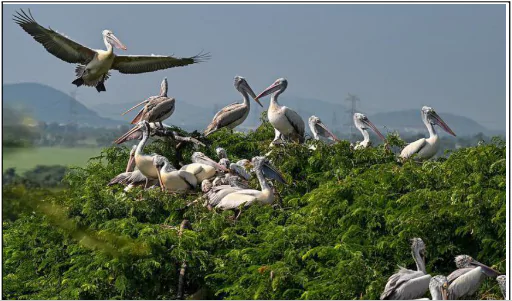Pelicans started arriving from Siberia at Telineelapuram Bird Sanctuary in the first week of November and will stay on till the end of March next year.
About Pelicans
- Habitat: Primarily inhabit coastal areas, lakes, and wetlands.
- Pelican populations in India have declined due to habitat loss, pollution, and human disturbance.

Spot-billed Pelican (Grey Pelican)
- Habitat: Shallow lowland freshwater bodies like lakes, reservoirs, and rivers.
- Diet: Primarily fish, crustaceans and amphibians.
- Behaviour: Social birds, often seen in large flocks.
- Life Cycle: Breed during the monsoon season, laying eggs in large communal nests.
- Conservation Status:
- IUCN Red List: Near Threatened
- Wildlife (Protection) Act, 1972: Schedule IV
Enroll now for UPSC Online Classes
Types of Pelicans Visiting India:
- Spot-billed Pelican: Common in India, frequently seen at Telineelapuram Bird Sanctuary, Andhra Pradesh, and Kolleru Lake, Andhra Pradesh.
- Great White Pelican: Visits Keoladeo National Park in Rajasthan; a large white pelican that migrates occasionally.
- Dalmatian Pelican: Occasionally visits Chilika Lake, Odisha; a large pelican with distinctive black wing spots.
About Flyway
- A Flyway is a geographical region within which a single or group of migratory species completes its annual cycle, i.e., breeding, molting, staging, and non-breeding.
- Migratory birds from 3 flyways (CAF, East Asian Australasian Flyway, and Asian East African Flyway) visit India.
- Central Asian Flyway (CAF): Extends from the northernmost breeding grounds in the Russian Federation (Siberia) to the southernmost non-breeding (wintering) grounds in West and South Asia, the Maldives, and British Indian Ocean Territory.
Convention on Migratory Species (CMS) or Bonn Convention
- Purpose: An international treaty aimed at conserving migratory species and their habitats signed in 1979 and in force since 1983.
- Member States: As of 2024, 131 countries are party to the Convention.
- India has also been a party to CMS since 1983.
- India has hosted several CMS meetings, including the 13th Conference of the Parties (COP13) in 2020.
- India has also signed several Memoranda of Understanding (MoUs) with CMS for the conservation of specific species, such as Siberian Cranes, Marine Turtles, Dugongs, and Raptors.
About BirdLife International
- Global partnership of conservation organisations (NGOs) that strives to conserve birds, their habitats, and global biodiversity, working with people towards sustainability in the use of natural resources.
- Founded in 1922 as the International Council for Bird Protection.
- Publications:
- Official Red List Authority for birds for the International Union for Conservation of Nature (IUCN).
- Also publishes Important Bird Areas (IBA) inventory.
Standardised criteria for the designation of IBAs
- Significant Numbers of Globally Threatened Bird Species : IBAs should host substantial populations of one or more bird species globally classified as threatened.
- Presence of Restricted-Range or Biome-Restricted Species: Designation considers sites that are part of a collection of locations collectively supporting a range of restricted-range or biome-restricted species.
- Exceptionally Large Numbers of Migratory or Congregatory Birds.
Check Out UPSC NCERT Textbooks From PW Store
Telineelapuram Bird Sanctuary
- Telineelapuram is a designated Important Bird Area (IBA) and is the prime location for the spot-billed pelicans for winter breeding.
- Location: Srikakulam district, Andhra Pradesh, India.
- Wildlife: Primarily known for migratory birds, especially the Spot-billed Pelican, which comes here for winter breeding. Other bird species include Painted Storks, Open-billed Storks, and various waterbirds.
- Water Bodies: The sanctuary is situated near the coast, with access to brackish water bodies and the Bay of Bengal.
- Vegetation: The sanctuary has a mix of Mangrove forests, coastal wetlands, and agricultural lands.
![]() 12 Nov 2024
12 Nov 2024


